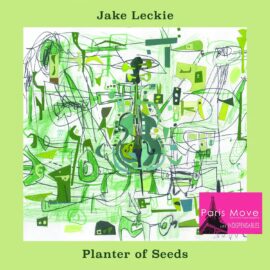| Jazz |

This is the third album by composer and double bassist Jake Leckie. Right from the start, you can feel his connection to the history of jazz. However, his work is completely contemporary and performed by excellent musicians. He explores the beauty that tomorrow can bring from the seeds we plant today. What are we planting? What are we building? What kind of village do we want to raise our children in? At the heart of the ensemble is The Guide Trio, his regular group featuring guitarist Nadav Peled and drummer Beth Goodfellow, who played on Leckie’s second album, The Guide, a rootsy, funky, acoustic, folk-jazz analog recording released by Ropeadope Records in 2022. For Planter of Seeds, the ensemble is enriched by Cathlene Pineda (piano), Randal Fisher (tenor saxophone), and Darius Christian (trombone), who bring freedom and soul to the already solidly established ensemble.
Exploring rhythms and melodies abundantly, setting scenes filled with life and undoubtedly personal experiences, beyond the high quality of the compositions, as a double bassist, Jake Leckie offers a performance with remarkable sound quality. A profound balance among the musicians is organized from track to track, structured around eight original compositions recorded live at Studio 3 of East West Studios in Hollywood, CA, and mastered by A.T. Michael MacDonald. The cover art is created by internationally renowned visual artist Wayne White. While his previous work has been compared to Charles Mingus and the American Quartet of Keith Jarrett with Charlie Haden, Leckie’s new collection comfortably sits between the funky rhythmic signatures of the Dave Holland Quintet and the modern folk-jazz of the Brian Blade Fellowship Band, with a respectful nod to the classic recordings of the late 1950s by Ahmad Jamal and Miles Davis.
This can indeed be noticed, but there is much more: a rhythmic and melodic vision that makes Leckie’s work perfectly recognizable. His way of playing with themes, expanding them, making them bounce back reminds me a bit of some works by Joe Zawinul, undoubtedly and very likely due to a musical culture in both cases that goes far beyond jazz. By incorporating codes from various forms of jazz, Leckie has a beautiful tendency to blur the lines. Each track presents itself to us like so many living paintings and adventures. And the work on this album is explained as follows:
The title track, “Planter of Seeds,” is dedicated to a close family friend from Trinidad, who, whenever she visited relatives or friends, would secretly plant seeds she kept in her pocket in their gardens. The following season, beautiful flowers would appear. It was a small, altruistic, and anonymous act of kindness that brought just a little more beauty into the world. The rhythm is a tribute to Ahmad Jamal, whom we also lost around the same time, and whose theme song Poinciana speaks of a Caribbean tree.
“Big Sur Jade” was written during a trip Leckie took with his wife to Big Sur, CA, and celebrates his family and community. This 5/4 blues opens with an unaccompanied bass solo, giving each musician the opportunity to share their improvisational voice. “Clear Skies” is a cathartic release of collective creative energies in a fiery improvisational freedom. “The Aquatic Uncle” showcases Randal Fisher’s saxophone and is named after an Italo Calvino short story that contemplates whether one can embrace new paths while staying in touch with tradition. In ancient times, before a rudder, the starboard side of the ship was where it was steered with a steering oar. In this meditative quartet performance, the bass is like the steering oar of the ensemble: it can control the direction of the music, and when things start to unravel or become chaotic, a simple pedal note keeps everything grounded.
The two trio pieces on the album prove that establishing his constant working group, The Guide Trio, has been a fruitful collaboration. “Santa Teresa,” a samba-blues in 7/8, embodies the winding streets and stairs of the bohemian district of Rio de Janeiro from which it takes its name. The swampy feel of the percussion on “String Song” pays homage to Levon Helm of The Band, a group where it is sometimes hard to tell who wrote the song or who is the band leader, proving that the sum is greater than the individual parts. Early jazz reflected egalitarianism in collective improvisation, and this group dynamic is an expression of that kind of inclusivity and democracy.
“The Daughters of the Moon” closes the album, highlighting naturalistic themes. This composition is named after Italo Calvino’s surrealist short story about consumerism, in which a mythical modern society that values only buying shiny, new things discards the moon as trash, and the daughters of the moon save and resurrect it. It is an eco-feminist vision of how women will save the world. Pineda’s final piano solo is a lunar journey of haunting beauty, dazzling us with love. Leckie dedicates this song to his daughter: “My hope is that my daughter becomes a daughter of the moon, helping to make the world a more beautiful and greener place to live.”
An intelligent work that touches each of us, playing with our sensitivities, imbued with a form of realism, adding grace to beauty, is simply the proposition of this album, making it one of our “Essentials.”
Thierry De Clemensat
USA correspondent – Paris-Move and ABS magazine
Editor in chief Bayou Blue Radio, Bayou Blue News
PARIS-MOVE, June 10th 2024
Follow PARIS-MOVE on X
::::::::::::::::::::::
